| For the section of this website entitled 'Driving', there's very little driving so far... Far more in the way of fettling really. Still, there is quite a long list of things to do before existing issues with the car are sorted, so let's get stuck in. Starting off with the ongoing battle to get the DL1/DASH2 combination working properly. |
| Sorted - I think. Buried deep in the morass of hapazardly thrown-together web-pages which passes for the support documetation for the DL1 is a page which suggests (albeit in a fairly oblique manner) that the DL1's native setting is for it to expect 2 pulses from the ECU per engine revolution. I assume that it expects to get a pulse every time the ignition driver triggers an ignition event on an I4 engine running wasted spark ignition. Anyway, this means that the DASH2, which is currently set up to expect 1 pulse every engine revolution, would indeed be expected to overread. I can fix this easily by reconfiguring the DASH2. Then I just have to sort out why the gear indicator's not working. |
| A quick recap. The DL1 can log 8 external inputs. At the moment, the
Furyracer has 11 external sensors - yaw rate, water temperature, oil temperature, oil pressure, front brake line
pressure, rear brake line pressure, throttle position sensor, steering angle, lambda, fuel and volts (which is
measured internally on the DL1 Mk1 but not the Mk2). That shouldn't be a problem, since the DASH2 has 4 external
inputs and should, in theory, be able to communicate these values to the DL1 over its serial port so that the DL1
can log these, and thus log 12 rather than 8 channels. Except it doesn't. The values for the DASH2's external sensors show up on the DASH2, the DASH2 is evidently receiving data from the DL1, as it's showing the values for the sensors connected to the DL1. Reflashing didn't work (as anticipated) and so Race Technology's support chap suggested plugging the DASH2 into the 'Monitor Lite' programme. Monitor Lite (as far as I can tell) simply takes whatever is coming out of a Race Technology product's serial port and shows the values coming out along with the refresh rate. So, it was out with the long daisy-chain of serial cables again. Connected to the DL1 (via a gender adaptor), Monitor Lite showed the expected range of values being sent from the DL1 via its serial point. Connected to the DASH2, it showed nothing. Not a sausage. There's nothing in the configuration file to disable or enable the DASH2 serial port, so it seems that there must be something awry with my DASH2 internally. I've replied to Race Technology telling them this - as yet, no reply. Hope does not spring eternal, but I'm still hoping for a reply. Maybe. |
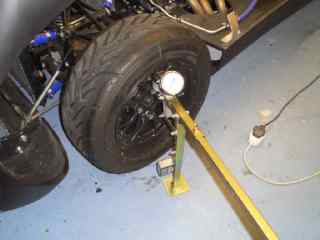 |
As the Furyracer is live axle, there's relatively little go adjust -
front caster, front camber, front toe, spring seat heights on all four corners, dampers on all four corners, front
ARB stiffness and Panhard rod length (not that the last one should require any fettling once the axle's central
relative to the chassis). Still enough to be getting on with... I'd already adjusted the front caster to 6 degrees, and the front camber to 2 degrees negative, and the front toe to 2mm of toe-in. However, doing the corner-weighting and ride height setup required either 1. Bags of heavy stuff in the car to simulate me; or 2. A willing assistant At present I haven't got round to going to the builder's merchant to buy some sacks of Dan-substitute, but this weekend I did have a willing assistant (subject to being provided with frequent cups of tea) in the form of the SO. We set the ride height first, using a homemade set of calipers (two lengths of angle ali bolted together) and a ruler - the chassis heights are now roughly 85mm at the front of the chassis and 100mm at the rear. The minimum ride height allowed in RGB racing is 75mm, but having been disqualified once for failing a ride height test I'd like to leave a little margin for error, and also the sump does protrude slightly below the floorpan. To do the corner weights (given the continued brokenness of Steve's corner weighting scales) I borrowed Tim's corner weight gauge, shown in the photo. The gauge is really just a long lever with a hydraulic master cylinder on one end attached to a pressure gauge, so it produces readings in PSI rather than kgs. On Tim's advice that the readings produced could vary if the bottom leg wasn't upright, I attached a magnetic inclinometer (the little silver box on the side of the bottom leg) to ensure that it was. There was one initial snag: the lever is quite long (just as well if the SO is going to be trying to lift up a quarter of a car with it) and with two Furies in the garage there wasn't enough clearance to do the corner-weighting in the garage. This meant pushing the car outside onto the driveway to do the corner-weighting, which is less than desirable since although the garage floor isn't perfectly flat, it's a damn sight flatter than the distinctly slopey driveway. |
| There are various theories about the best way to corner-weight a car
- should you aim to equalise the weights of the front wheels, so that you get even braking and turn in (ignoring
the effect of the rear wheels on both)? Should you try to equalise the diagonals - the aggregates of the front
left/rear right and front right/rear left wheels? Of course the ideal would be to have FL=FR and RL=RR with the
front/rear weight distribution whatever you'd decided best for the car (usually 60% rear/40% front for a race car,
despite BMW's widely advertised claims to the contrary for road cars). However, this can only be done by physically
shifting weight around the car, and there's only a limited degree to which this can be done on an RGB car. The RGB cars are of course pretty light - even with me on board, I'm hoping to get the FuryRacer down reasonably close to the 530kg minimum weight limit (more of that later). There are certain masses which can't be moved - the rear axle location is fixed, there's not much flexibility as to where the wheels go, or the dampers, or the brakes, or the uprights etc. There are of course 2 major masses in the car - me, and the engine/gearbox. Neither can be moved particularly easily from their intended positions. To a degree these cancel out - I'm on the right hand side of the car, while the engine is on the left hand side of the car. The trouble, of course, is that I'm predominantly on the rear right hand side of the car, while the engine is over on the left but towards the front of the car. The net effect is that the front right corner is fairly light, and the rear left corner is significantly lighter than the right rear corner. I've always thought that the equalise-the-diagonals method of corner-weighting made the most sense to me (the equalise-the-fronts never seemed to have a sensible explanation as to why it was a good idea) so that's what we aimed for. Doing the corner weighting involved me sitting in the car, while the SO jacked each corner up in turn and noted the results on a spreadsheet. Then I'd hop out of the car, look at the figures with her, decide what needed adjusting, make a note of the adjustments I was about to do, jack up the appropriate end(s) of the car, adjust the spring seats, drop the car down to the ground, get in the car, jump up and down a bit to bounce the car and settle the suspension, sit down, and start the whole process again. In the end we got a 50.3%/49.7% balance between the two diagonals, which given the inherent inaccuracies in the uneven ground, the fact I didn't slacken off the bolts holding metalastic bushes in the rear suspension arms off, and the fact that the results from the corner weighting gauge didn't seem all that repeatable that seemed close enough. One interesting fact from the corner-weighting was that (apart from one set of results which seemed a bit screwy) the spreadsheet showed a fairly consistent all-up weight for me and the car of about 535kg. As I mentioned above, the corner-weight gauge produces a reading in psi rather than kg but the spreadsheet (also blagged off Tim) has a conversion factor to convert psi into kg. According to Tim, it's not particularly accurate but is generally good to 5kg. If so, then I'm in serious danger of the car being underweight. These measurements were carried out with virtually a full tank of fuel, which weighs at least 20kg, and which won't be in the car at the end of a race. If the car, with a virtually-full tank of fuel, and me, in it does indeed weight 535kg then I'm going to have to start bolting sheets of lead onto the floor on the passenger side. I'm a bit sceptical that this figure is correct, though. The weight at SVA was supposedly 460kg, which with me at 90kg (wearing very heavy clothes, of course) gives a total weight of 550kg. OK, so I've removed a few things after SVA - the passenger seat and harness, the trim pieces on the interior, the (mostly steel) crash pad etc. I'd be rather surprised if they all added up to 15kg, however. Still, all will be revealed when I go testing at Snetterton since once I'm there I can put the car, with me in it in my race gear, on the weighbridge and get an accurate reading. And for the medium (long?) term there is in the air a cunning plan for corner-weighting involving 5 load cells I've bought from a nice chap in China, some aluminium plates, some circuit boards and some coding, the latter two elements being done by people far better as such things than I am. If all goes to plan the end result will be a set of 4 wireless Bluetooth corner weight scales for about 400 quid. Which would be nice. |
| And finally, to remind me what some of the various unmarked switches do, I've made up these little labels with the help of Steve, a laser marker, and a big bag of black anodised lozenge-shaped plates, just in case I forgot which kill-switch does what, or in case I forget which way the bias adjuster works. Nice... | 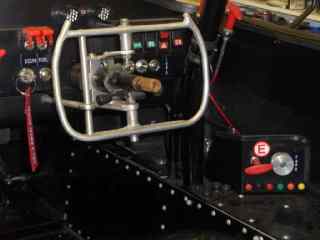 |
| Ignominy, ignominy - they've all got it ignominy. No that doesn't really
work - much like the FuryRacer on Thursday night, and ignominy was present in abundance. Having sorted the major
issues I'd identified on the initial shakedown runs, I decided it was time to introduce the FuryRacer formally
to the cam7 collective at cam7's spontaneously-organised-but-always-the-same-place-on-a-Thursday-evening get together,
the legendary P&F. The drive there was uneventful (although just before I got to the pub the tacho stopped
working for some mysterious reason). After much wibbling, it was time to leave and after a wee bit of tyre kicking
I set off. All was going nicely until I was about to turn off the A14 onto the A10 at the Milton roundabout. At which point the car started missing intermittently, at about the time same as the DASH2 started blinking up a warning light about low voltage levels. I just about managed to nurse the car up the exit ramp and over the roundabout. By the time I'd done this the car was to all intents and purposes electrically dead as the proverbial door-nail. If you left the ignition off for a few minutes then the DASH2 would illuminate for long enough to tell you that the battery voltage was at about 6V, but the fuel pump wasn't even priming and the starter-interlock relays were drawing more power than the battery could supply, and clicking on and off. Driving up the A10 clearly wasn't an option as things stood. So I rang the mighty Billiam, who rode valiantly to my rescue armed with a tow-rope, a bike light, some gaffer tape and some jump leads. We tried the jump leads first - but with William's car connected to the FuryRacer, the dash was still showing only 6V, suggesting that there was some serious sulphation and short-circuiting in the FuryRacer's battery. Even after leaving it charging for 10 minutes the battery was still dead. Even more mysteriously, if we jumped the car off William's car, and then pulled the jump leads, the engine would stop dead. This is worrying, as the alternator should be producing enough power to keep the car running, although given that it's a bike engine I suppose it's possible that it's unable to do so at idle, and that the engine revs would need to be above a certain level to produce sufficient power just to drive the fuel pump and engine electronics. Seems unlikely, however. This suggested to me that I was suffering from a seriously goosed regulator, perhaps damaged when I tested the electric reverse mechanism earlier. Either way, I was driving nowhere unless it was side-by-side with William with the jump leads running between the two cars, so William towed me home on the world's shortest tow-rope. Towing a small matt-black car down an unlit road at midnight - nice. Still, it got back me back home in good time. I put the battery on charge, the Optimate kicked straight into 'Desulphate' mode, and that was my first FuryRacer breakdown. So, bad FuryRacer, good Billiam... |
| On the basis that, regardless of whatever had caused the problem in
the first place, the battery was now terminally poorly, it was time to source a new battery. Normally I get bike
batteries from MDS Batteries, who used to sponsor the RGB race series. However, for a YTX10S battery (which
is standard fitment on 2004-06 R1s and which I'd fitted originally) they wanted £99.99. That struck me as
being a less than tempting option. Although Halfords, as expected, couldn't provide the correct battery (although they did have a pleasingly cheap Bosch YTX9S for Striker - I'm not having much luck with batteries recently), I did manage to find one at the Yamaha dealer in Cambridge. The good news was it was £62, and the extra good news was that they reduced it to £52 because it didn't have a box. I celebrated by spanking the change from £100 on a new Optimate 4, just in case the Optimate 3 had in fact been damaged when I'd forgotten to disconnect it before driving the car out of the garage... I've also acquired a replacement regulator/rectifier off eBay - another £60 - to see if that makes any difference. Since I was planning to get a spare one anyway, there's no real reason not to do so. |
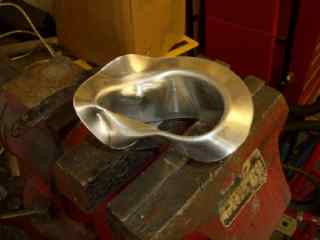 |
That still leaves oil cooling. And when in doubt, copy Tim. Tim's tried
to reduce his oil temperatures by ducting air onto the oil/water heat exchanger
on the engine. This seemed like a reasonable plan, so I thought that once again I'd copy it. So I bought some 51mm
duct from Merlin
Motorsport, along with a rather natty little adaptor. This
was a top-hat shaped piece of spun ali, with a short tube with a 51mm OD and a 10mm-ish flange. This would make
it an easy job - cut a 51mm hole using a holesaw in the recess where the indicators originally went on the Fury,
fit the adaptor with some PU gloop, bung on a length of hose. Job done, 15 min max, time for a NCoT. Erm. Well, the theory was good. However, the flange on the adaptor was too big, and needed to be turned down. For which the obvious tool of choice was of course the lathe. However, when I was turning down the flange, the tool evidently dug in, with the result that my labour-saving natty little adaptor turned instantly into the mangled mess on the left. |
| ...to point at the heat exchanger. | 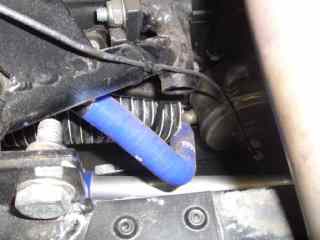 |
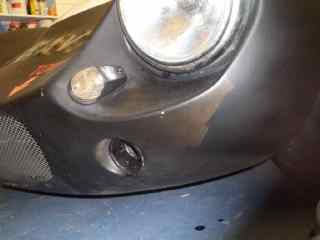 |
It even looks tolerably tidy from the outside too. |
| Well, that was a rather enjoyable day. The beginning was rather less enjoyable, as getting up at 4.20am is rarely going to be fun. Of course I'd planned to have a nice early night. But as I was lying in bed, trying against force of habit to get to sleep before midnight, I started thinking about the cam cover breather I'd fitted to the cam cover. And how I'd fitted the bolts on the outside of the breather, leaving the nylocs holding it in place inside the cam cover. In a hot, oily environment subject to high vibration levels. In hindsight this seemed like a bad idea, and it seemed a much better idea would be to put the bolts in from the bottom and have the nylocs on the top of the cam cover. I tried to reassure myself that it had worked like this all the way to the P&F and back, but it was no good. So I got up again, took the cam cover off, reassembled the breather, cleaned the sealant off the head, laid on some new sealant, refitted the cam cover and went back to bed. Having eventually managed to get out of bed, I went over to the Shed, picked up the trailer, and went to pick up Tim from his house. I was aware that most people don't appreciate a good hearty ring on the doorbell at 6.15am, so I tapped gently on the front door, and stood waiting. It turns out that Tim hadn't heard me, and was in fact coming to the front door to open it so that I wouldn't have to ring on the doorbell. As a result, he got an almighty shock to find some swarthy chap standing right in front of him. Happily, Tim's heart survived the shock, and we set off back to my house to pick up the car, and then headed off to Snetterton. Having got there I signed in, got the key for the garage, unloaded the car and went to get the car noise tested. I was a bit concerned about this, as although the car had passed SVA, this was based on a fairly modest estimate of max power revs, and also was in all likelihood tested at half the revs it should have been due to the DASH2 not having been set up properly - i.e. at about 3000rpm rather than over 6000. However, even at a genuine 7krpm the car passed the 105dBa noise test easily at 99dBa. After that we headed back to the pits, and pushed the car in between the narrow gap between my trailer and the race transporter next to it (which had brought a lovely E-type racer into the other half of the garage). My first session started at 9am, so I donned my race suit, balaclava, helmet, gloves, etc. and got in the car ready to head off onto the track. Feeling rather nervous, I went to start the car. It turned over, but wouldn't fire. I tried it a few times, but it was no good. Bugger. So Tim and I pushed the car back into the garage, and we set about trying to fix it. It was fairly obvious that the problem was the fuel pump - when the ignition's turned on the ECU switches on the fuel pump for about 5 seconds to prime the fuel system. Except it wasn't. So we started pulling apart connectors, testing the various outputs and inputs with a multimeter, and I started wondering whether the tip-over switch bypass which had caused me so many problems when I first tried to start the engine was the problem. Eventually we decided to test the fuel pump by using a long piece of wire to connect it directly to the battery, and Tim went off to find a long piece of wire. As he was walking off, I looked down at the dash. And noticed that the kill-switch cover for the fuel pump switch was down. Doh! By this stage there wasn't much of the first session left, but I went out anyway just for a 4 lap outing to make sure everything was now working. It was, although Tim was concerned that my hot tyre pressures were a bit low, although after only 4 pretty gentle laps of the circuit the water temperature was already up to 95degC and the oil temperature was 115degC, which suggested my efforts to improve the car's cooling weren't necessarily working all that well. We checked for air-locks and any other obvious problem but couldn't find any, and I decided to keep going anyway, although the temperatures kept going up and up. In the second session Tim carried on checking the tyre pressures and decided we needed some more air in the tyres. I'd started off doing laps in the 1:30 area, but soon started pressing a bit harder. Although it sounds moderately daft, driving the virtual Snetterton circuit on rFactor was a definite help to learning the circuit, although driving the circuit on a computer gives you no impression of the banking on the inside of the Bombhole corner. The temperatures kept on going up and up, but seemed to stabilise at 140degC for the oil and 105 for the water. Both are considerably higher than I'd like, particularly the water temperatures, but the car seemed happy enough to run at those temperatures so once again I decided to just carry on. During the second session I put one lap in which was a 1:22.5, so I was getting faster, although most of my laps were in the 1:24s and 25s. One highlight of the second session was driving around a Chevy Camaro (the 60s one, not the new version) which obviously had a lot of power. Down the straights it powered away from me, but on the corners it would've been faster to walk. I got past it a couple of times under braking - but every time we got to the Revett straight it got past me. It was fun for a while, but then it got boring, so I came into the pits just as the session ended. |
| After lunch, I basically just went out and put in lap after lap. Whereas
in the first two sessions I was normally circulating with the Stock Hatch cars and overtaking nothing, after lunch
I started pushing harder and trying to run at my own pace rather than being slowed down too much by the traffic.
This did result in a few hairy moments, some of which were caused by me getting distracted by the presence of other
cars and forgetting to brake (especially for Riches) and some as a result of some Stock Hatch drivers having no
idea what their mirrors were for. Including one silver hatch who put me partially on the grass just before Riches
by swerving across the track at the last moment. The slower cars did prove fun in places though - I passed an MR2
on the outside of Coram which made me ridiculously satisfied. There were a few red flags during this session, including a stoppage caused by one of the MR2s dumping fluid on the track in the start of the Esses. This resulted in me turning into the Esses only to be faced by the side of a gently-pirouetting red Fiesta, but thankfully I was still so far from the limit that I had amply time to slow down and take avoiding action. My lap times were a bit up and down during this session, but one useful thing did come of it. There were some other RGB drivers there, including a chap called Richard Wise who drives a class C Striker. He came past me at quite a rate of knots round Coram, and told Tim afterwards that I was turning in too late for the Bombhole but too early into Coram. Tim gave me a few tips on the Bombhole (turn in early and use the banking on the inside, clipping the drain cover at the apex) and on Coram (turn in late, use the red and white concrete on the inside, and let the car drift out on the exit under full power), which proved to be very useful later on. |
| I've now had a chance to look through the data from the DL1 - I couldn't
do so at the time since my laptop refused to recognise the CF card reader supplied with the DL1, although I can't
blame the laptop since the CF reader's made by Belkin. It turns out that my best lap was a 1:21.38, although most
of my laps were 1:22 and 1:23s. A 1:21.38 would put me about 2/3rds down the field based on the qualifying results
from last year, which is a frankly terrifying prospect, particularly as I haven't done a race start in the FuryRacer
yet. Good points from the test day are: 1. The car seems to run reliably with no major problems, and handles nicely - fairly soft and understeery but very adjustable and very catchable when things get squirrely. I had great fun drifting the car through Sears and the Bombhole, and although it's an indication that I'm not taking enough speed through either it shows the car's nicely responsive when the back end steps out 2. I'm not *that* slow. Who knows, I may not even get lapped in the race... 3. The bonnet bulge'o'doom wasn't a distraction and I had no problem seeing over it. It may be different at other tracks, but at Snett it doesn't seem to be a problem. Car issues are: 1. Temperatures. While the temperatures stabilise after a while, they're too high. I suspect that this is a result of the oil temperatures getting too high and dragging the water temperature up, but I suspect I'll have to admit that Tim is right and I need a spangly but expensive alloy radiator. 2. The DASH2 is giving some fairly strange readings, particularly on the gear indicator, which seems to believe that first and sixth gears don't exist. Quite frankly the gear indicator was actively unhelpful as it simply distracted me rather than helping. I'm hoping I can resolve that by tweaking the settings. 3. The front left tyre's rubbing on the bodywork, so I may need to cut away more of the bonnet on the return on the wheel arch. 4. The bonnet's lifting at speed. What I really need to do is duct the radiator outlet through the bodywork, but there's no simple way of doing it. I'll think about how it might be possible, though. 5. The seat's not right - there's too much material underneath my thighs, and my legs could do with being straighter and flatter. And finally, driving issues are: 1. Brakes. I'm not using them enough, and certainly in the early sessions even the Stock Hatches were taking chunks of time out of me under braking, particularly into Russell. However, as I keep on reminding myself, you need to get lines sorted first, then getting out of the corners, and braking comes last in the list. 2. Gear shifts - I need to practice clutchless gear up-shifts to get them smoother, and I need to work on my heel and toeing - I haven't got it sussed on this car yet, but it'll come with practice. I think that generally I need to get used to where the car's limits are, as I'm not really getting that close to them in most corners, but it'll come. As a first outing, certainly, I'm very happy with how things went. Many thanks to Tim for provinding moral support and pit-monkey services, and for the photos I've used above. |
| Scrutineering was a bit embarrassing. The scrutineer noticed that all
6 of the locknuts on the rosejoints on the front suspension were finger-tight at best. The rosejoints wouldn't
actually go anywhere, and the front suspension would stay on the car, but wasn't exactly the start I'd hoped for.
I ran off and got my toolbox, tightened up the locknuts, paid my £2 for an MSA sticker for my helmet, and
all was well. Tim and I took the opportunity to stick both me and the car on the weighbridge, given my concerns that the car might be underweight. No such luck - with me in it the car weighed 565kg, a chunky 35kg over the minimum weight limit. More cycling, fewer doughnuts... |
| After a couple of laps to settle in, I ended up behind Neil C-B again. I managed to get past him at Sears, but he stuck to my tail on the exit and managed to out-drag me down the Revett straight, so I was back where I started again. I was a fair bit faster than Neil through the Bombhole (thanks again to Tim's Top Tips) but there's not much of a straight between the Bombhole and Coram. I could just get the nose of my car alongside him, but as he turned in I had to back off, and as I'd taken a tighter line into Coram it compromised my exit. During these abortive attempts to get past, James Fowley was getting closer and closer. Since he's got a fair bit more grunt in his car, I could see myself slipping back another place if I stayed behind Neil, so I spent the Revett straight thinking about how to get past. I decided that the best option was to use my extra speed through the Bombhole to stay tight on Neil's tail, turn in extra late into Coram (again using Tim's Top Tips) and then try and get up the inside of him into Russell. And blow me, it worked. I nailed it through the Bombhole, stayed right up behind Neil until he turned in, and then waited until the very last moment to turn in, got the power on early, drove over the concrete that Tim had told me to drive over and got alongside Neil into Russell. I braked as late as I dared, turned in, and I was past. |
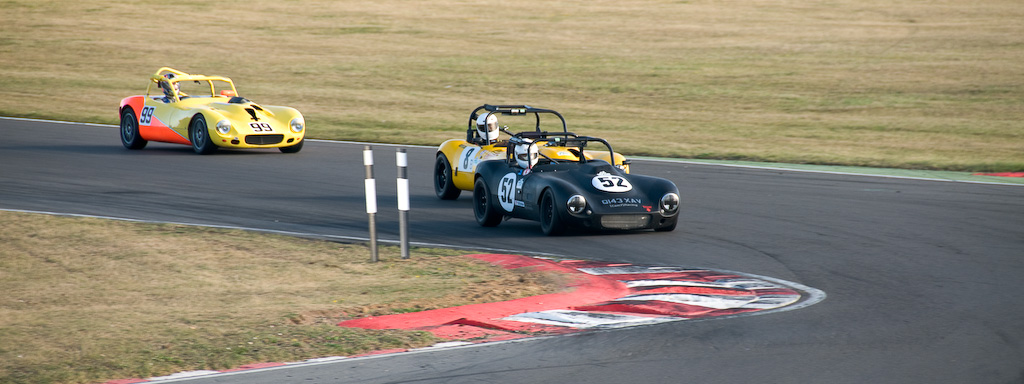
| And there it is. My first ever overtaking move in RGB racing that I've made stick. As you can see from the lack of clearance between tarmac and bonnet, I did leave my braking fairly late and was braking quite hard at this point. The next cars ahead were Phil Alcock and then my old sparring partner Neil Palmer, so I started chasing them down. While I was doing so, I came round the Russell chicane and noticed Richard's car parked reasonably firmly into the barrier on the outside of the chicane. I think this distracted me, as the car got a bit sideways through the middle of the chicane, which I hadn't done previously. Unfortunately I suspect I'd missed a yellow flag at Coram, which is something I need to work on as I suspect I missed a red flag at Coram in testing. The marshall's post at Coram isn't exactly in the line of sight, and I was concentrating pretty hard on driving at that point on the circuit. However, that's no excuse, and I think flag observation is something I'll have to work on. Quite apart from the fact that the flags are an important safety feature, SWMBO is a flag marshal, and she'll give me a right kicking if I don't... |
| Getting past Neil proved to be disappointingly easy, as I simply drove
past him on the Revett straight. I was back on the racing line well in time for braking into the Esses. With Neil
having 40bhp less than me and with the larger frontal area of the Fulcrum, I suppose this was hardly surprising.
For the next few laps I circulated all alone, with the next car up the road being a considerable distance ahead
of me. On my penultimate lap I set my best lap time, a 1:20.15, half a second better than my best qualifying lap.
Then, on the 11th lap, I saw some headlamps behind me as I was on the Revett straight - it was Derek coming up
to lap me. I feathered the throttle slightly at the end of the straight to allow him to get past easily, and then
stayed wide going into Coram to allow Paul Rogers past in his menacingly matt-black mid-engined Contour. Hopefully
I didn't inconvenience either of them too much. End result, 10th out of 15 finishers,1 lap down (just) on the leaders. Although I did inadvertently try to join the podium celebrations - Derek and Paul were the only two cars ahead of me, and at the end of the race they drove down the pitlane and stopped at the end. The marshal's hand-signals were of the generally-waving-my-hands-around variety rather than imparting any useful information as to where I was actually supposed to go, so I just stopped behind Paul assuming it was a post-race technical scrutineering. Of course, they'd stopped there since it was next to the podium. Ahem. Blush. Thankfully the Fury has good steering lock so I was able to get out from behind Paul and follow everyone else off the circuit without too much fuss. In fact, if only the commentator hadn't referred to it over the circuit's PA system, I might've got away with it... ;) All-in-all, then, a great day out. The car ran reliably and is easy to drive, being predictable and forgiving on the limit. There's clearly a fair bit of speed to come from the driver - I was nearly 3 seconds down on Tim's best time, and slower than a couple of the Class C cars - but I'm getting there and will keep working on it over the winter by hopefully doing lots of testing and quite possibly some driver training too. In the meantime I'm going to go over the data logs and see what they tell me. Many thanks to Tim for all his help over testing and on race day, to Neil for providing me with a motivating blue target on so many occasions, and Jonathan for the photographs I've used above. Congratulations to Colin Chapman for his first Class C victory and to Derek for his overall victory. Bring on the 2010 season... |
| At this stage there's not really that much point doing any particularly intensive analysis of the data logs - the car appears to be largely behaving itself, it's definitely faster than the driver, and I know what I need to do better - accelerate harder and sooner, brake later and harder, and go round the corners faster. However, there's no point having the data logger if I don't use the data, and apart from anything else it's good practice in using the Race Technology Analysis software which isn't exactly intuitive in some respects. The data certainly shows where I've improved between Friday and Sunday. |